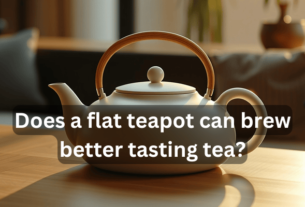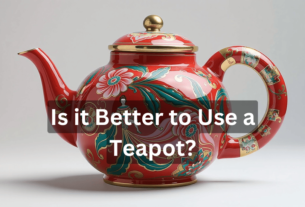Is a Chocolate Teapot a Metaphor? When you think of chocolate, you might picture a sweet treat that melts in your mouth. And when you think of a teapot, you likely imagine a sturdy object that holds hot tea. But what happens when you combine the two? A chocolate teapot sounds delicious, doesn’t it? Yet, in reality, it wouldn’t be very practical. The phrase “chocolate teapot” has become a well-known metaphor, often used to describe something useless or ineffective.
Is a Chocolate Teapot a Metaphor? In this article, we’ll explore what makes the chocolate teapot a popular metaphor, why it captures people’s imagination, and how it can be applied to real-life situations. We’ll also look at other similar expressions that add color to the English language. So, let’s dive in and find out why a chocolate teapot means more than meets the eye!
The Meaning Behind “Chocolate Teapot”
When someone uses the expression “as useful as a chocolate teapot,” they are saying that whatever they are referring to is completely impractical or ineffective.
Just think about it: a teapot is designed to brew and serve tea, while chocolate melts when hot. Therefore, a chocolate teapot would be utterly useless for its intended purpose.
This metaphor effectively conveys frustration or disappointment. It can be used in various contexts, including everyday situations, workplace discussions, or even in literature to reflect characters’ feelings.
For instance, if a new gadget doesn’t work as advertised, someone might exclaim, “This is as useful as a chocolate teapot!” In this way, the phrase succinctly communicates their dissatisfaction.
Exploring the Origins and Usage of Metaphors in Language
Now that we have a taste of the metaphorical menu, let’s dig into the history and psychology behind these linguistic gems.
From ancient poets to modern psychologists, the evolution of metaphorical language has always fascinated scholars and thinkers alike. So, grab your metaphorical shovel, and let’s unearth the hidden treasures of metaphorical expression!
Historical Evolution of Metaphorical Language:
Metaphors have been swirling in the linguistic soup since the dawn of human communication. Ancient civilizations used metaphors in myths, fables, and religious texts to convey complex ideas in a digestible format.

Is Enamel Good for a Teapot? Best In 2025..
Over time, metaphors evolved from ornamental rhetoric to essential tools for shaping our understanding of the world. From Shakespearean sonnets to contemporary memes, metaphors continue to shape our language and cultural narratives.
Psychological and Cognitive Aspects of Metaphors:
Beyond their historical roots, metaphors also have a profound impact on our brains and behaviors. Psychologists suggest that our brains process metaphors not as mere linguistic quirks but as concrete experiences.
This cognitive blending of abstract and concrete domains enhances our comprehension and memory retention. So, when we say, “Time flies,” our brains might actually envision a winged clock soaring through the sky.
Why Do We Love Metaphors?
Metaphors appeal to us for several reasons. Here are some key points that illustrate their value in communication:
- Creativity and Imagination: Metaphors encourage creativity. When we use or hear a metaphor, we engage our imagination, picturing the scenes and ideas being illustrated.
- Simplicity and Clarity: Sometimes, complex concepts can be hard to explain. A metaphor can break things down into simpler, relatable terms. Saying “life is a journey” is easier to grasp than trying to explain the highs and lows we all face.
- Emotional Connection: Metaphors evoke emotions. A beautifully crafted metaphor can resonate with our feelings and experiences, forging a connection between the speaker and listener.
- Cultural Significance: Many metaphors draw from shared cultural experiences, making them a glue that binds communities together. They can reflect values, humor, and local customs.
- Engagement: Metaphors keep language interesting. Instead of flat, straightforward statements, metaphors add flair and depth, encouraging people to think critically and explore meanings.
Is a Chocolate Teapot a Metaphor?
Examples of the Chocolate Teapot Metaphor in Real Life
The chocolate teapot metaphor can be used in many situations. Here are some examples:
- A Broken Tool
If you’re trying to fix something with a tool that doesn’t work properly, you might say, “This tool is as useful as a chocolate teapot!” - A Poorly Designed Plan
Imagine a business launching a new product without doing any market research. If the product fails, people might describe the marketing strategy as “a chocolate teapot” because it wasn’t well thought out. - Useless Advice
If someone gives advice that doesn’t help or is completely impractical, you could use the metaphor to point out how unhelpful it is.
Other Similar Metaphors
The chocolate teapot isn’t the only metaphor that highlights uselessness. Here are a few more idiomatic expressions with similar meanings:
- “As useful as a chocolate fireguard” – This compares something useless to a fireguard made of chocolate, which would obviously melt in front of a fire.
- “As useful as a screen door on a submarine” – A screen door is designed to let air in, which wouldn’t be very helpful on a submarine!
- “As useful as a fish on a bicycle” – This humorous phrase highlights how unnecessary or out of place something might be.
Each of these metaphors uses humor and exaggeration to make a point.
Analyzing the Symbolism Behind the Chocolate Teapot Metaphor
Now, let’s turn our attention to the star of the show – the chocolate teapot metaphor. This quirky analogy has stirred curiosity and contemplation among language aficionados and tea lovers alike. Let’s brew some thoughts and savor the symbolism hidden within this delectable metaphor.
Understanding the Chocolate Teapot Metaphor:
Imagine a fragile teapot made of chocolate – a delightful yet impractical vessel for brewing tea. This whimsical imagery captures the essence of something that is charming but utterly useless for its intended purpose.
The chocolate teapot metaphor playfully illustrates the idea of something being as ineffective as trying to brew tea in a sweet, melty teapot. It’s a flavorful way to express skepticism or doubt about the practicality of a situation.

Is it Better to Use a Teapot? In 2024
Interpreting Symbolism and Meaning:
Beyond its literal interpretation, the chocolate teapot metaphor invites us to reflect on the broader themes of futility, fragility, and absurdity. It challenges us to question the utility of objects, ideas, or actions in our lives.
So, the next time you encounter a chocolate teapot situation, pause, smirk, and appreciate the bittersweet lesson it imparts about the quirks of human existence.
Conclusion
The chocolate teapot might be a symbol of uselessness, but it’s far from pointless. As a metaphor, it adds humor, color, and creativity to our language. It reminds us to think carefully, laugh at life’s absurdities, and stay open to unexpected possibilities.
So, the next time you hear someone say, “That’s as useful as a chocolate teapot,” remember the deeper message behind the joke. And who knows? Maybe one day, you’ll come up with your own version of a chocolate teapot – something that surprises, delights, and proves that even the most unlikely ideas can have value.



